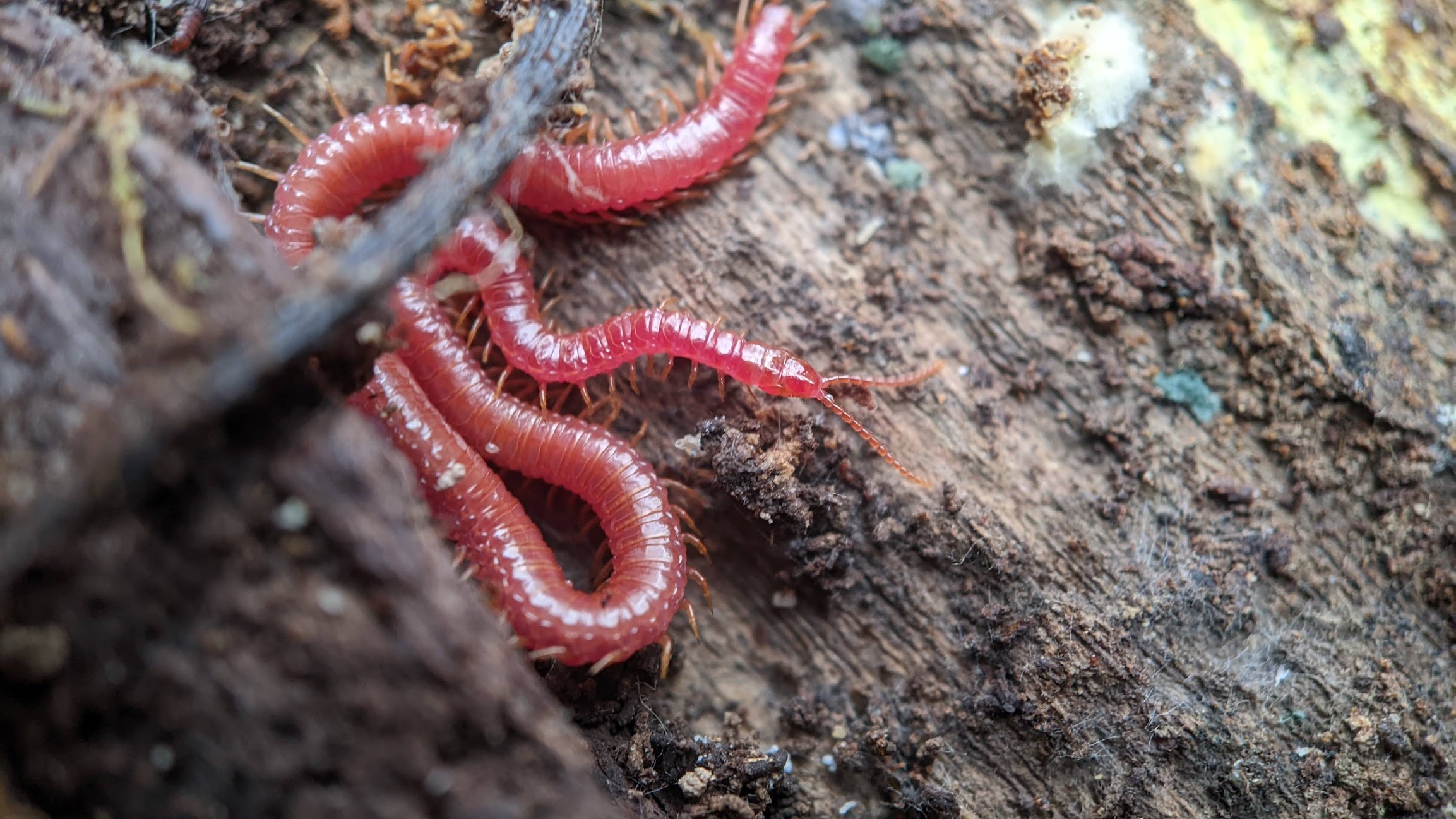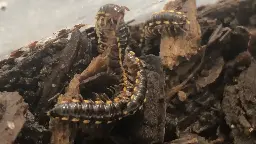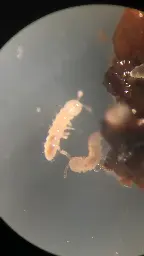
Isopods and Myriapods
- Meet the Giant Centipedes! Ferocious Predators and Caring Mothers....Mega Post Part 2

cross-posted from: https://lemmy.ml/post/12863454
> Main Photo 'Scolopendra-hardwickei2' by Steven Lenaerts......a caring mother! > > > > Part 1 here > > Next up, size wise is Scolopendra cataracta... > > >Scolopendra cataracta is a species of centipede in the family Scolopendridae. It is the first known amphibious centipede, growing to up to 20 centimetres (7.9 in) in length > > ! > > Photo by NELSON SANCHO > > >When exposed, it escapes into water. It both runs along stream beds and swims with eel-like horizontal undulations of its body. Out of water, water rolls off the centipede's body leaving it dry as the surface is hydrophobic. The species was discovered, and the first specimen collected, in 2000 near Thailand's Khao Sok National Park. Two more specimens were collected near waterfalls in Laos > > Next is Scolopendra heros > > >...commonly known as the Arizona desert centipede, giant desert centipede, giant Sonoran centipede, Texas black-tailed centipede, Texas redheaded centipede, and giant redheaded centipede, is a species of North American centipede found in the Southwestern United States and Northern Mexico. > > >[It] is the largest centipede in North America. It has an average length of 6.5 inches (170 mm), but can reach up to 8 in (200 mm) in the wild, and even longer in captivity....It is aposematically colored, to warn off potential predators > > > ! > > Photo by Lat3ralus > > > >For humans, a bite from S. heros usually causes sharp, searing, local pain and swelling, but has never caused any confirmed deaths > > Scolopendra mutilans aka The Chinese red-headed centipede (and the Chinese red head averages around 20 cm > > > ! > > Photo by pompogna > > >S. mutilans is known for harbouring little aggression to other centipedes, a trait very rare amongst giant centipedes, and allows it to be kept communally. Antimicrobial activities of the identified compounds were reported against Gram-positive and Gram-negative bacteria, fungi, viruses, and parasites, that possibly explain centipede's survival in harsh and polluted environments. > > >Females are incubator mothers, guarding the eggs by wrapping their bodies around their clutches until the eggs hatch. > > Scolopendra subspinipes is an active, and aggressive predator, growing up to 20 cm and found throughout southeastern Asia. > > >....in 2018 a far larger specimen was recovered in Hawaii by Clayton Cambra, who captured what appeared to be a Scolopendra subspinipes that measured an astonishing 36.6 cm in length > > ! > > Photo by Chien Lee > > >[It is] one of the most widespread and common species in the genus Scolopendra, it is also found on virtually all land areas around and within the Indian Ocean, all of tropical and subtropical Asia from Russia to the islands of Malaysia and Indonesia, Australia, South and Central America, the Caribbean islands, and possibly parts of the southern United States, but how much of this range is natural and how much due to human introduction is unclear. With a wide geographic range and numerous color variations, the species is known by many common names, including jungle centipede, orange-legged centipede, Hawaiian centipede, and Vietnamese centipede > > >.....[an] aggressive and nervous arthropod, ready to strike if interfered with and sensitive to vibrations nearby. It preys primarily on arachnids, including spiders, scorpions, and vinegaroons. It is large enough to overpower small vertebrates, such as mice or small reptiles, and will readily attempt to consume them. It tends to try to eat almost every living animal it encounters that is not longer than itself. It seizes prey with its anterior legs and then uses its toxicognaths to inject venom. The prey is held by the centipede's other legs until it is subdued. When defending itself or attacking prey, the centipede uses its entire body, coiling around the animal and holding on with its legs, from which position it can use its toxicognaths to deliver venom > > >The male produces capsules containing mature sperm cells, spermatophores, which are deposited in a reservoir called the spermatheca of the female during mating. The female then fertilizes her immature eggs...and deposits them in a dark, protected area. The female lays 50 to 80 eggs, which she vigilantly protects until they hatch and the baby centipedes molt once. If danger is detected, she wraps around her young to keep them safe > > >S. subspinipes venom normally causes extreme pain, among other symptoms. A fatal case was reported in the Philippines in which the centipede bit a 7-year-old girl on her head. She died 29 hours later > > Next is Scolopendra galapagoensis, aka the Galápagos centipede, and Darwin's goliath centipede which can grow up to 30 cm > > > ! > > Photo by Martin > > > It is the only representative of the genus Scolopendra on the Galapagos Islands, among twelve other species of centipede present on the Islands. It is also found on mainland South America in Ecuador and Peru, and on Cocos Island in Costa Rica > > It comes in 3 colour morphs Dark green to black and Orange-red (above and below) > > > ! > > Photo by Tom Schultz > > >S. galapagoensis has been reported preying on crickets, newborn rodents, the Galapagos Rice Rat, and, in one paper, a Floreana Racer snake. It is hunted by a variety of birds of prey including the Galapagos hawk, two species of mockingbird, and the common Black Rat > > And finally, the biggest of them all the Scolopendra gigantea! > > > ! > > Photo by Martin > > >....also known as the Peruvian giant yellow-leg centipede or Amazonian giant centipede, is a centipede in the genus Scolopendra. It is the largest centipede species in the world, with a length exceeding 30 centimetres (12 in) > > >It is a carnivore that feeds on any other animal it can overpower and kill. It is capable of overpowering not only other invertebrates such as large insects, worms, snails, spiders, millipedes, scorpions, and even tarantulas, but also small vertebrates including small lizards, frogs (up to 95 millimetres (3+3⁄4 in) long), snakes (up to 25 centimetres (10 in) long), sparrow-sized birds, mice, and bats > > >Large individuals of S. gigantea have been known to employ unique strategies to catch bats with muscular strength. They climb cave ceilings and hold or manipulate their heavier prey with only a few legs attached to the ceiling. > > > ! > > Photo will be from BBC, but I haven't found a link, as yet > > >Natural predators to the giant centipedes include large birds, spiders, and arthropod-hunting mammals, including coati, kinkajou, and opossum. > > >At least one human death has been attributed to the venom of S. gigantea. In 2014, a four-year-old child in Venezuela died after being bitten by a giant centipede which was hidden inside an open soda can. Researchers at Universidad de Oriente later confirmed the specimen to be S. gigante > > DON'T TOUCH IT!!! > > ! > > Photo by Kurt (Orionmystery) G > > Well, I hope you enjoyed the posts! > > Here's a fun palette cleanser if you've scrolled this far....Scolopendra hardwickei as lego (or something like that) > > ! > > Photo by Middle Brick > > Sources here and wikipedia, here here here here here and here >
- Meet the Giant Centipedes! Ferocious Predators and Caring Mothers....Mega Post, Part 1

cross-posted from: https://lemmy.ml/post/12861296
> Main photo by Nicky Bay > > Scolopendra are a large species of centipede, both in number (around 100 different types), and often just large in body size > > They are found in warm temperate regions, and in the tropics. The largest discovered (so far) can exceed 30 cm (12 in) > > All Scolopendra are active preditors and are venemous, capable of delivering a painful (and in one reported case fatal) bite to humans via their forcipules (These are not fangs or other mouth parts, but modified legs on their first body segment) > > > ! > > 'Scolopendra subspinipes' by > Lilian Alizert > > >The venom of certain Scolopendra species were found to contain compounds such as serotonin, haemolytic phospholipase, a cardiotoxic protein, and a cytolysin > > > They feed primarily on other insects and invertebrates, some of the larger varieties have been observed preying on frogs, tarantulas, lizards, birds, snakes, rodents, and even bats! > > >Two southeast Asian species, S. cataracta and S. paradoxa, as well as S. alcyona from the Ryukyu Islands, are amphibious, as these species can travel underwater by swimming or walking > > They have been discovered in the fossil records. Scolopendra proavita was found in Baltic amber from the Eocene of Poland. Other fossil species S. morsitans have been found Pliocene-aged rocks in South Africa > > According to this article, these are the largest giant centipedes found (so far)..... > > Scolopendra alternans, commonly known as the Haitian giant centipede, Caribbean giant centipede, and Florida Keys centipede, and are around 17-19 cm on length > > > ! > > Photo by Sylvain Coulon > > >Scolopendra alternans is found in Puerto Rico, Cuba, Guadeloupe, Martinique, Venezuela the Bahamas, Hispaniola, the Antilles, the British Virgin Islands, and Florida. They have also been reported as far north as Georgia > > Next is..... > > >Scolopendra viridicornis is a species of centipede in the family Scolopendridae which can be found within the Amazon rainforest, the type locality being in Brazil. Due to the geographic distribution of this species it is known as the Amazonian giant centipede > > > ! > > Photo by Scolomorph > > > >Scolopendra viridicornis is quite quick to flee when disturbed by a predator, running away with impressive speed. If pursued the centipede will raise its terminal legs in an attempt to draw any attack to its hind end. When a predator touches these raised limbs the centipede will use them to grip its aggressor and spin around to deliver a venomous bite. The centipede will then continue to flee until it finds safety. > > >In northeast Brazil, S. viridicornis is used in regional folk medicine as an analgesic. The species possesses a peptide in its body known as lacrain which exhibits strong antimicrobial effects against Gram-negative bacteria > > Next up is Scolopendra hardwickei, the Indian tiger centipede > > >It is a pigmented species, with exceptionally bright and contrasting coloration, alternating dark orange and deep black segments, with dark orange legs > > ! > > Photo by Martin > > >This species is common in the south of the Indian peninsula and it is rarely found on the islands of Sumatra and Nicobar > > >The bite of S. hardwickei can cause swelling and drowsiness > > And finally, Scolopendra polymorpha which can grow up to 18 cm > > >Scolopendra polymorpha, the common desert centipede, tiger centipede, banded desert centipede, or Sonoran Desert centipede, is a centipede species found in western North America and the Hawaiian Islands > > ! > > Photo by Alice Abela > > >S. polymorpha is indigenous to the Southwestern United States and northern Mexico, north to the Pacific coast.[3][4] It inhabits dry grasslands, forest, and desert; in these habitats, the centipedes generally take up residence under rocks, though they have been observed creating burrows in suitable environments and inside rotting logs. > Scolopendra polymorpha as found in the Tonto Forest near Payson, Arizona > > >Scolopendra polymorpha is indigenous to the deserts of western North America; in Texas, New Mexico, and Arizona in the United States, and in Sonora and Chihuahua in northern Mexico. They primarily seek shelter during the day in moist, cool areas such as under desert rocks > > >The venom of Scolopendra polymorpha has been found to be medically relevant.....against Staphylococcus aureus and Pseudomonas aeruginosa, two bacteria that are the leading causes of nosocomial infections..... [And] activity against Escherichia coli, which can cause food poisoning, pneumonia, and urinary tract infections > > Sources here and good old wikipedia, here, here, here, here, and here > > Part 2 to follow! > > edit Part 2 here
- Does anyone know how to get rid of fungus gnats?
I'm having trouble with fungus gnats in one of my isopod containers. Whenever I replenish the humidity in that container they have an population explosion, but I can't let the container get too dry since that's going to kill my isopods.
Does anyone have a solution for this that's not going to be harmful for my isopods?
- Found this eastern red centipede coiled around her eggs while I was out looking for millipedes today

I believe this is Scolopocryptops sexspinosus, the eastern red centipede. Females protect the clutch from predators and mold spores, and some species also protect young after they hatch.
- my first Ducky Offspring or Just some guest from the Woods?

I discoverd this tiny Dude this morning, the only known isopods in this bin are Rubber Duckys. Can i celebrate my first Babyducky?
- How do isopods taste?

A juvenile Clark's anemone fish, with a friend. A horrific, tounge-eating friend. Bangka island, Sulawesi, Indonesia.
- Oxidus matingvimeo.com Oxidus millipede mating
This is "Oxidus millipede mating" by Heather Bruce on Vimeo, the home for high quality videos and the people who love them.

They face each other during copulation. The male's head is on top.
- Oxidus millipede 1-day old hatchling, exploring the world for the first time <3vimeo.com millipede Oxidus hatchling
Oxidus gracilis 1-day old hatchling from my lab colony. On agar and mulch

- Welcome, share your love for pods and pedes!
Welcome isopod and myriapod enthusiasts! Feel free to introduce yourselves, talk about your keep lists, etc.
I'm located in the midwest and I've been keeping isopods and millipedes for a couple years. I have 30 isopod colonies and 10 millipede colonies. I'm picking up three new-to-me millipede species at a reptile show tomorrow and I'm pretty excited to get them home in their new setups.

